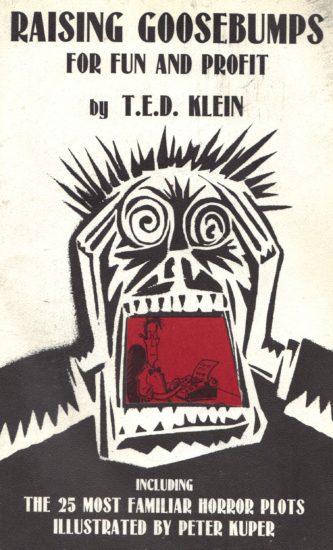 By T.E.D. KLEIN, PETER KUPER (Footsteps Press; 1988)
By T.E.D. KLEIN, PETER KUPER (Footsteps Press; 1988)
This “Brief Guide, for Beginners, to the How’s and Why’s of Horror” was written by T.E.D. Klein, horror author extraordinaire (of THE CEREMONIES and DARK GODS) and former editor of The Twilight Zone magazine. He is, in short, a guy whose advice you’d definitely want to pay close attention, and aspiring horror scribes could certainly do worse than to read this book.
Klein’s argument, originally published in shorter form in Writer’s Digest magazine, is that horror fiction exists primarily to reassure (it’s no accident that one of Klein’s collections is titled REASSURING TALES), providing a fictional outlet for our real-life anxieties. He further proclaims that “the pleasure of horror fiction depends upon the fundamental unreality of the horror,” and that “One isn’t scared by a horror tale; one is “scared.””
T.E.D. Klein, keep in mind, is the guy who once said “There’s something singularly uninviting about a book that proclaims it’ll keep you awake nights biting your nails. Where’s the fun in that?” His preferred brand of horror is the subdued and suggestive type practiced by the likes of H.P. Lovecraft, M.R. James and Algernon Blackwood, all of whom are frequently referenced. Authors like Thomas Harris and Jack Ketchum have no place in Klein’s pantheon, and nor does Clive Barker, whose story “Jaqueline Ess: Her Last Will and Testament” is singled out as an example of “the current trend toward explicit violence and gross physical detail” that Klein deplores.
Obviously I’m not in total agreement with Klein’s thesis, but I can’t deny the thoroughness and intelligence with which he makes it. He utilizes plenty of well-chosen quotations by intellects like C.S. Lewis, Arthur Koestler and even Albert Einstein, yet maintains a friendly conversational style that never grates or overstays its welcome.
In truth this book’s selling point is the “25 Most Familiar Horror Plots” listing that concludes it. Illustrated in appealingly sarcastic and cartoony fashion by Peter Kuper (of Mad Magazine’s “Spy vs. Spy”), it contains self-explanatory entries like “I’m Really in Hell!,” “The Magic Typewriter,” “The Living House,” “You Can’t Cheat Fate” and “It Was Only a Dream,” all inspired by the submissions Klein received during his Twilight Zone tenure. Klein’s commentaries on the various entries are witty, informed and always on the mark. The list made for one of the more memorable portions of the essential BOOK OF LISTS: HORROR (2008), though without the Kuper illustrations or Klein’s preceding essay, which taken together make for a worthwhile collector’s item.
